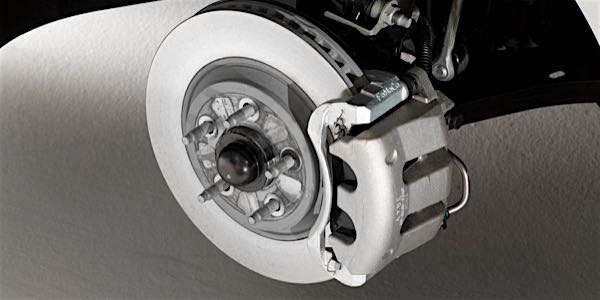
The brakes on 2005-2014 Mustangs are fairly standard, with discs both in the front and rear. The front calipers are of the dual piston variety, while the rear calipers have single pistons. Four-wheel anti-lock brakes are standard on all models.
The only major difference in the brake systems between the base V6 models and the V8-powered GT models is the size of the rotors. The V6-powered Mustangs have 11.5-inch front rotors, while the GT models have larger 12.4-inch front rotors. The rear rotors on both models are 11.8 inches in diameter, but are narrower than the ones up front.
BRAKE ISSUES
To date, there have been no major problems with the brakes on these Mustangs. Other than the normal wear one would expect, the brakes have been reliable and relatively trouble free — with one exception.
On the 2005 and 2006 models, there have been some reports of the rear parking brake cables freezing up during cold weather. Apparently, road splash gets past the parking brake cable end seals, puddles inside the cable and freezes. This may prevent the parking brake from releasing, causing the rear brakes to drag. Ford issued TSB 06-5-4 on Feb. 20, 2006 covering this problem, and recommends fixing it by replacing the original parking brake cables with new redesigned cables that are more water resistant.
The pads should also be replaced if there is more than 3 mm of taper in any direction, if the pads have been contaminated with brake fluid from a leaky brake caliper or if the owner is complaining about squealing or groaning brake noise.
If these models need new pads, you also need to measure the rotors to see how much they are worn — even if they appear to be relatively smooth with no serious grooving, cracking or visible hard spots (discolored patches). The minimum rotor thickness specification for the front rotors on both the V6 and V8 Mustangs is 28.4 mm (1.11 inches) and 17.4 mm (0.68) inches for the rear rotors.
If a rotor still has enough metal left in it for another go around, but needs to be resurfaced to smooth up the surface, the minimum “machine to” spec is about 0.6 mm more than the minimum thickness specification: 29 mm for the V6 and V8 front rotors (30.6 mm for the Shelby front rotors), and 18 mm for the rear rotors. This spec will allow for wear until the next time the brake pads are replaced.
PERFORMANCE UPGRADE OPTIONS
Many Mustang owners are good prospects for brake performance upgrades. If the pads and/or rotors need to be replaced anyway, it’s not a hard sell to convince certain customers that stopping quick is just as important as going fast. The most popular brake upgrades include performance aftermarket brake pads made with friction materials that can handle higher braking temperatures and drilled/slotted/grooved rotors that provide improved cooling and venting of hot gases from the pads.
The nice thing about selling and installing performance upgrades is that it can add a great deal of profitability to what would otherwise be a standard brake job. Most of these upgrades are simple bolt-on installations that require few, if any, modifications. The only thing you have to watch out for is making sure there is adequate clearance between the inside of the wheel and the caliper when larger rotors are installed.
The front rotors on a V6 Mustang can be upgraded to the larger stock V8 rotors, but require 17-inch or larger wheels for clearance. If a set of 13- or 14-inch aftermarket performance rotors are being mounted in place of the stock GT rotors, the wheels have to be 18 inches or larger, depending on the calipers.
Article courtesy Brake & Front End.














